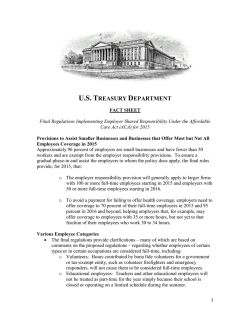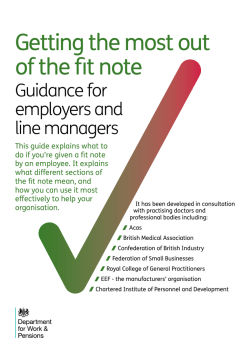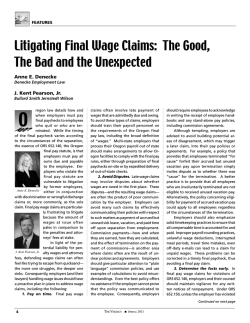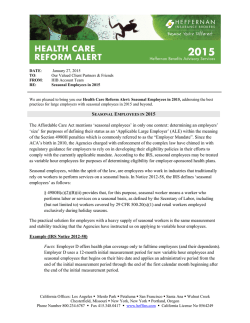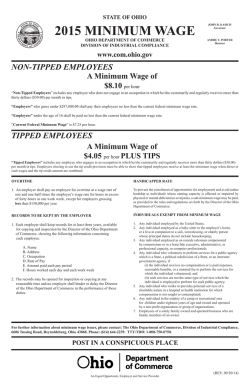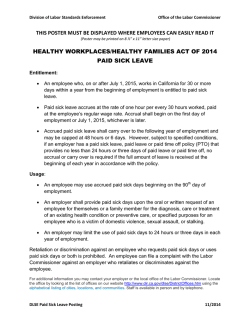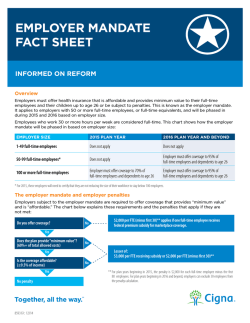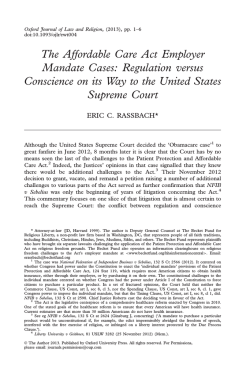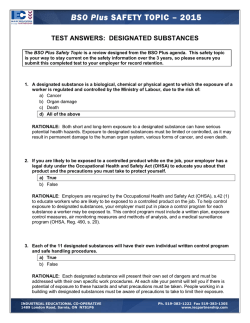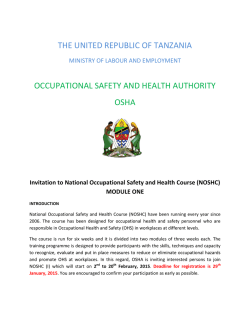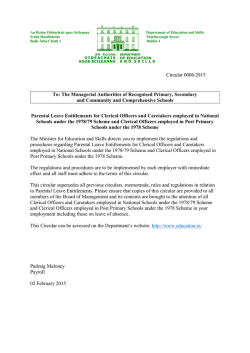
Fit note guide for GP
Getting the most out of the fit note GP guidance Based on research evidence and feedback from doctors, patients and employers, this guide is designed to help you make best use of the fit note to support your patients. It gives you information on completing each section of the fit note (including the reassessment box, comments section and return to work tick boxes), and uses case studies to illustrate different situations. It updates previous guidance, reflects new developments such as the introduction of Fit for Work, and has an expanded further support section. You can also use it for Continuing Professional Development and revalidation purposes. It has been developed in consultation with practising doctors and professional bodies including: Acas British Medical Association Confederation of British Industry Royal College of General Practitioners EEF - the manufacturers’ organisation Chartered Institute of Personnel and Development 2 Getting the most out of the fit note This guide can be read through in order, or you can refer to specific sections independently as follows: Key messages 2 How the fit note can help you3 What is the evidence behind the fit note and this guide? 5 o you need to issue a fit note? How to D assess a patient’s fitness for work 7 Filling in the fit note: instructions for completion 11 iving advice in the fit note – G the tick boxes and the comments box 12 How your patient will use their fit note 14 The fit note in action – best practice case studies 15 Additional questions 19 Further information and support 22 CPD reflective note guidance and template 26 Key messages Your assessment about whether your patient is fit for work is about their fitness for work in general and is not job-specific. If you assess that your patient’s fitness for work is not impaired by a health condition, they are fit for work and do not need a fit note. Always consider if your patient could do work of some kind before advising that they are not fit for any work. Remember the long-term health risks of worklessness when advising your patient that they are not fit for work. You should use the fit note to give advice about the functional effects of your patient’s condition on their fitness for work in general. You are not expected to have specialist knowledge of workplaces or occupational health, and you do not need to suggest possible changes to your patient’s workplace or job. When stating a patient maybe fit for work you should tick whichever return to work boxes relate to your advice. Use the comments box to give further information. If you do have specialist occupational health knowledge you can go into further detail about possible adaptations if you think this would help. If you require more specialist occupational health advice and your patient is unemployed and has been, or is likely to be on sick leave for four weeks or more, you can refer them to Fit for Work which will carry out an occupational health assessment and provide them with a Return to Work plan. A fit note may be required to cover the first two weeks of sickness absence from when a referral is made to a Fit for Work assessment. Once a Return to Work Plan has been issued, this can be used in place of a fit note. You can also access the advice line or use their website to get general health and work advice. GP guidance 3 How the fit note can help you The fit note can be a key tool for you to use to improve your patient’s health and be an advocate for their wellbeing. The benefits of using the fit note to its full potential The fit note is designed to help you provide fitness for work advice to your patients. This guide will help you use the fit note to its maximum potential to improve your patient’s health and wellbeing. In particular, using the fit note to its full potential enables you to: • Effectively manage your patient’s expectations about their capability for work. • Give a clear clinical assessment to your patient about the impact of their condition on their fitness for work. • Improve the likelihood of your patient keeping their job, by helping them to discuss ways they could be supported at work with their employer. • Support the vital role that work can play in your patient’s health, as set out in the evidence behind the fit note. On the other hand, incomplete fit notes can make it hard for employers to support your patient and cause unnecessary delays to your patient’s return to work (with associated consequences for their health). They can also cause additional work for you as patients ask you for new fit notes when they may not need to. The role of GPs All GPs are able to provide simple fitness for work advice to their patients to help them return to work, and aid their recovery. It is then up to your patient and their employer to discuss your advice and consider possible changes. There is a general consensus1 that GPs and other healthcare professionals: • play a key role in advising patients about (return to) work; • agree that (return to) work is an important health outcome for clinical management; • help patients develop a return-to-work plan; • facilitate return to work through shared decision making • enable patients to effectively communicate with their employers. “In the same way as we encourage healthy eating, healthy living and healthy lifestyle, a healthy attitude to work has always been a part of that.” (GP) 1. Healthcare Professionals’ Consensus Statement – Statement of Health and Work (2008). http://www.nhs.uk/Livewell/workplacehealth/Documents/hwwb-healthcare-professionals-consensus-statement-04-03-2008.pdf 4 Getting the most out of the fit note Supporting clinical management Computer-generated fit notes Work is now recognised as an important health outcome: Fit notes can be handwritten or computergenerated and printed out. Computer-generated fit notes have the added benefits of: • Discuss fitness for work with your patients where appropriate. • Consider if they may be fit for some work. • Complete all relevant sections of the fit note, to provide as much useful advice as possible to your patient and their employer. • In particular, complete the comments box with advice on the functional effects of your patient’s health condition. • Consider your own training needs on health and work, and build your knowledge of other support and resources. • Consider using the Fit for Work advice line for general health and return to work advice or signpost patients to access the support. • Consider a referral to Fit for Work which will carry out an occupational health assessment and produce a Return to Work plan. Whilst a patient is engaged with Fit for work the return to work plan eliminates the need to complete repeat fit notes. “You might imagine that people would come in wanting a sick note because they want time off work but most of the time that I’ve suggested they actually might be fit with adaptations, they’re quite open to it, which has surprised me a bit.” (GP) • Automatically completing certain parts of the fit note to save you having to fill them in each time you issue one. • Ensuring that your advice is easy to read for patients and employers. • Removing the need for you to re-write fit notes if duplicates are required, as other staff members can print out duplicate copies. • Enabling clinical management and fitness for work advice to be monitored together for patients with long-term conditions. • Improving the continuity of patient care generally – for example if patients are seen by different GPs. • Allowing you to share knowledge and learning points with colleagues in your practice by carrying out appropriate internal audits. All GP practices now have access to computergenerated fit notes. More information is available at: https://www.gov.uk/government/collections/fitnote GP guidance 5 What is the evidence behind the fit note and this guide? The fit note is built on robust evidence, which this guide helps you translate into practical support for your patient. Most importantly, the evidence is clear that patients benefit from being in some kind of regular work. This improves mental and physical health and can aid recovery. “Work is useful and it’s actually really detrimental if I’m just signing people off.” (GP) “I think work improves people’s health if they’re in a job that’s giving them job satisfaction, income and a routine in their day - it can be very beneficial for most people to go back to work.” (GP) Evidence behind the fit note’s principles Patients are happy for their GP to give them advice on work issues2, and do not feel that this threatens the doctor-patient relationship3. Most GPs agree that work is generally beneficial for health, and that they play an important role in helping patients return to work4. The fit note helps you to discuss work with your patients. Appropriate work is generally good for physical and mental health5 and people do not have to be 100% fit in order to work in most cases6. The fit note supports people to work when they can. The longer a patient is off work the lower their chances are of making any return to work7. The fit note helps you to support people to return to work as soon as appropriate. Most people with common health problems can be helped to return to work by following a few basic principles of healthcare and workplace management8. The fit note support this by allowing you to give advice about your patient’s health condition and how it can be managed in the workplace. Improving communication between GPs, patients and employers leads to faster return to work and people have the best chance of returning to work if the clinical management of their health condition is linked to the workplace9. The fit note captures your advice clearly for your patient and their employer. This allows a more effective conversation between the employer and your patient to accommodate a return to work. 2. Collingwood, S. (2011). Attitudes to health and work amongst the working-age population DWP Research Report No 763 https://www.gov.uk/government/uploads/system/uploads/attachment_data/file/214544/rrep763.pdf 3. O’Brien et al (2008). Sickness certification in the general practice consultation: the patients’ perspective, a qualitative study. Cardiff University www.ncbi.nlm.nih.gov/pubmed/18245795 4. Hann M and Sibbald B (2011). General Practitioners’ attitudes towards patients’ health and work DWP Research Report 733. https://www.gov.uk/government/uploads/system/uploads/attachment_data/file/214507/rrep733.pdf 5. Waddell, G. and Burton, A.K. (2006), Is work good for your health and well-being? TSO www.dwp.gov.uk/docs/hwwb-is-work-good-for-you.pdf 6. Waddell, G., Burton, A.K. and Kendall, N.A.S. (2008). Vocational Rehabilitation, what works, for whom and when? TSO https://www.gov.uk/government/publications/vocational-rehabilitation-scientific-evidence-review 7. Ibid, footnote 5 8. Ibid, footnote 6 9. Ibid, footnote 6 6 Getting the most out of the fit note If you are unsure about how to help your patient or their needs may be more complex you may wish to make a referral to Fit for Work. Your patient can then share their fit note and your assessment of their condition with the service for more expert advice. “We didn’t used to make adjustments… The fit note helps a lot more now and I would like to see more people coming back with adjustments.” (Employer) “I was actually keen to return to work, and see how people were doing. So it was a personal thing, personal fulfilment more than anything.” (Patient) The fit note so far The fit note was launched in April 2010 to replace the old sick note. It allows doctors to give more information to patients about the functional effects of their health condition on their fitness for work, to help people return to work where appropriate. Since then, our ongoing evaluation programme has helped us understand how we can support doctors, patients and employers to get the most out of the fit note. We have used this research to inform this guide, along with revised guidance for employers and patients. The key themes to emerge were10: • Patients told us that the fit note had helped them challenge assumptions from some employers that people with a health condition cannot work, and had empowered them to agree changes with their employer and return to work. • Employers wanted more use of the may be fit for work option, so that they could explore whether employees could be supported to return to work. In particular they wanted clearer and fuller information in the comments section about the employees functional capabilities. • GPs told us that the fit note had helped patients make a phased return to work. It had helped to guide discussions with patients about fitness for work, including challenging some patients’ perceptions of their fitness for work. “There used to be so many situations where you thought to yourself ‘Well there is no option on the form to say this person is probably okay to go back to work but maybe not do their normal job’.” (GP) 10. Hann, M. and Sibbald, B. (2011). General Practitioners’ attitudes towards patients’ health and work DWP Research Report 733. https://www.gov.uk/government/uploads/system/uploads/attachment_data/file/214507/rrep733.pdf Fylan, B., Fylan, F. and Caveney, L. (2011). An evaluation of the Statement of Fitness for Work: qualitative research with General Practitioners. DWP Research Report 780. http://research.dwp.gov.uk/asd/asd5/rports2011-2012/rrep780.pdf Lalani, M., Meadows, P., Metcalf, H. and Rolfe, H. (2012). An evaluation of the Statement of Fitness for Work: qualitative research with employers and employees. DWP Research Report 797. https://www.gov.uk/government/uploads/system/uploads/attachment_data/ file/214584/rrep797.pdf GP guidance 7 Do you need to issue a fit note? How do you assess a patient’s fitness for work? If you assess that your patient’s fitness for work is not impaired by their health condition, they are fit for work and do not need a fit note. This is the default position for all patients. You also do not need to issue a fit note for the first seven calendar days of a patient’s sickness absence. Patients can self-certify for this period. If you assess that your patient’s health affects their fitness for work, you should give them a fit note indicating whether your patient is not fit for work OR may be fit for work. Following an assessment by Fit for Work you, your patient and their employer (subject to your patient’s consent) will be provided with a Return to Work Plan which can be used as evidence in place of a fit note. Assessing your patient’s fitness for work Your assessment about whether your patient is fit for work is about their fitness for work in general and is not job-specific. The following factors may be useful when making this assessment: • Any functional limitations of your patient’s health condition. For example: – Stamina e.g. better in the morning or the afternoon – Mobility e.g. walking, bending, stooping – Agility e.g. dexterity, posture, co-ordination – Insight / Stability e.g. mental state, mood – Treatment e.g. side-effects, duration of – Intellectual e.g. cognitive abilities – Sensory e.g. hearing, vision, touch. • The duration of their health condition and any likely fluctuation. • The impact of any ongoing clinical management. • Whether doing any work (not necessarily their current job) will make their health condition worse. Deciding between ticking may be fit for work or not fit for work q M ay be fit for work taking account of the following advice Your patient may be fit for work, taking account of your advice about the functional effects of their condition. You should tick this box if your patient could do some form of work (not specifically their current job). This gives maximum flexibility to your patient and their employer to discuss ways to accommodate your patient’s condition (which may include changing their duties for a while or reducing their hours). For example, a delivery driver who cannot drive may still be able to do other tasks and so may be fit for work – as described in case study four. “Initially I treated them like old-style sick notes and ticked an awful lot of ‘You’re not fit to work’ (boxes) as a kind of black and white thing … over time, I started thinking ‘Hold on, this is a bit richer’ and I use it a different way.” (GP) 8 q N ot fit for work Your patient is not fit for work of any kind. You should tick this box only if your patient cannot do any form of work at all. Always consider if your patient could do work of some kind. Assessing that your patient is not fit for work when there are still things they can do risks depriving them of the chance to discuss ways they could do some work with their employer; and increases the long-term health risks of worklessness. If you assess that your patient is not fit for any work, make sure that you continue to review their fitness for work at regular intervals. See case study five for an example of a situation when it may be appropriate to assess that someone is not fit for work of any kind. You now need to fill in the rest of the fit note. See Filling in the fit note for advice on how to do this. If your patient has been off work sick for four weeks, or you think they are likely to be off work for that long, you can refer them to Fit for Work. You can refer them whether you think they may be fit for work or if they are not fit for work. The Fit for Work assessment will provide advice on interventions in a Return to Work Plan to help support your patient back into work. This will be shared with you and the employer subject to your patient’s consent. Getting the most out of the fit note A fit note may be required to cover the first two weeks of sickness absence from when a referral is made to a Fit for Work assessment. Once a Return to Work Plan has been issued this can be used in place of a fit note. See case study 2 for an example of a situation when it may be appropriate to refer someone to Fit for Work. Discussing patient beliefs about health and work Patient beliefs about health and work vary widely and normally become apparent during a consultation. As with other health advice, you should emphasise the advantages to the patient’s health of being at work. This information will not always be embraced enthusiastically. Sometimes, reluctance to consider work stems from a belief that work will exacerbate the health problem or delay recovery, or that patients always need to be fully fit before they return to work. You may be able to ease any apprehension in these cases. At other times, people may have issues at work, low expectations of gaining enjoyable work, concern about the effects on benefit receipt or other personal problems. In these circumstances it may be in your patient’s best interest if you refer them to other available support. GP guidance Where appropriate, the following approaches may help in discussing work with your patients: • Discussing the health benefits of work, and the health risks of not working. • Explaining that people do not need to be 100% fit to do some work. • Issuing fit notes for shorter periods of time. • Using the fit note to actively engage patients in goal setting. • Telling your patient about other support services if they have non-medical issues that are affecting their attitude towards work. • Specialist occupational health services can help address complex issues at work, including if your patient’s work may be affecting their health. “You don’t want to go down a road where everything centres around your health. You want to have a life apart from that and that’s the good thing about going back to work – you’re dealing with people and you have a routine to your life again’.” (Patient) “I think the GP was very helpful actually. Having spoken to him I felt better about going back to work and just doing what I could, and taking the odd day off here and there when I needed to.” (Patient) 9 Getting the most out of the fit note 6 7 8 5 4 3 2 1 If you assess that your patient is not fit for work, or may be fit for work (see advice on making this assessment), you will need to issue them with a fit note. Filling in the fit note: instructions for completion 10 GP guidance 11 Filling in the fit note You can either: You can issue a fit note on the day that you assess your patient; or on any day afterwards. • The fit note should be completed as follows: • 1The date on which you assessed your patient. This can be via: • a face-to-face or telephone consultation; or • consideration of a written report from another doctor or healthcare professional (for example, nurses, occupational therapists, physiotherapists). 2Describe the condition(s) that affect your patient’s fitness for work. Give as accurate a diagnosis as possible, unless you think a precise diagnosis will damage your patient’s wellbeing or position with their employer. 3Tick not fit for work OR may be fit for work taking account of the following advice advice on making this assessment. 4The comments box must be completed when you tick may be fit for work, and may be useful to complete when you have ticked not fit for work. See giving advice in the fit note for more information. You can record whether you have made a referral to Fit for Work here, or your reason for not referring, if relevant. See giving advice in the fit note for more information. 5Indicate the period that your advice applies for. This may be the date that you expect your patient to have recovered by, or your judgement about an appropriate time to review their fitness for work even if they are unlikely to have fully recovered. specify a period from the date of the assessment (as entered in box 1) e.g. this will be the case for two weeks; or specify a particular start and end date. e.g. this will be the case from 5 May to 19 May. In the first six months of a patient’s condition, a fit note can cover a maximum of three months. If a condition has lasted longer than six months, a fit note can be for any clinically appropriate period up to ‘an indefinite period’. The dates are inclusive, (so a fit note dated from 2 April to 10 April will no longer apply from 11 April onwards). 6 This section is mandatory – it gives your patient an indication about whether they can expect to be fit for work when the fit note expires, which helps them and their employer plan for the future. If you expect that your patient will be fit for work at the end of their fit note, indicate that you will not need to assess them again. If you don’t expect them to be fit for work (or you aren’t sure), indicate that you will need to assess them again. 7Sign the fit note using ink. If you are using the computer-generated fit note, the statement date and address of your practice will be completed automatically by your IT software. If not, ensure that these sections are filled in. 8Complete the date of statement. This is the date that you issue the fit note – which may not necessarily be the same as the assessment date in box 1. IMPORTANT: Your patient can go back to work at any point they feel able to, even if this is before their fit note expires. They do not need to come back to see you in order to do so, or get a new fit note. This is the case even if you have indicated that you need to assess them again. 12 Getting the most out of the fit note Giving advice in the fit note – the comments box The comments box must be completed when you have assessed your patient as may be fit for work, and can be useful to complete when you have assessed them as not fit for work. You should use the free text section to give advice about the functional effects of your patient’s health condition, and tick boxes to provide an overview of the factors your advice covers. The free text section The important information to include in this box is advice about the functional effects of your patient’s condition on their fitness for work. Your patient and their employer should then discuss possible adaptations and changes to accommodate your advice. Your advice should focus on what your patient can do at work rather than their diagnosis and symptoms. It is helpful to give advice that is as practical as possible. See some examples in the checklist opposite. You do not need to be an occupational health expert to provide this advice, and you do not need to refer to their current job. If you do have occupational health expertise or information about your patient’s job, you can describe possible adaptations if you think this would help. But remember not to be too prescriptive and inadvertently reduce your patient’s potential to be able to return to work. Otherwise, the only reference to your patient’s current job should be if you feel that it may be affecting their health. In these cases, you should explain why this is the case, so that your patient’s employer can try to address the issue. An occupational health assessment is often helpful in these cases. If you think a referral to Fit for Work is useful, you can record that you have made a referral. If you decide the patient is eligible but you decided not to refer to Fit for Work you can if you feel it is helpful record your reasons for not doing so. The checklist below may be useful when considering what to include in the comments box • Are there things your patient cannot do in terms of mobility, strength and fitness? e.g. ‘avoid kneeling and squatting / cannot lift heavy objects’ • Are there types of activities that should be avoided or altered? e.g. ‘removal of tasks which cause emotional distress / avoid driving’ • How long is this likely to be the case, or will it be permanent? e.g. ‘condition expected to improve within two months’ • Will medical appointments be needed during working hours? e.g. ‘will need to attend physiotherapy for one hour twice a week’ • Are there features of the workplace which may impact the patient’s condition? e.g. ‘their chair may be aggravating their back condition’ • Could they benefit from an occupational health assessment? • Have you referred them to Fit for Work? • Is there return-to-work guidance available from Royal Colleges or other groups on your patient’s specific condition or operation? “I don’t put anything about the job that the patient does. I just put ‘back pain means they can’t lift heavy objects’ or something like that.” (GP) GP guidance Your liability for the advice you provide goes no further than your responsibility to carry out a suitable clinical assessment of your patient’s health condition. Your patient’s employer is responsible for undertaking a suitable risk assessment to accommodate your clinical judgment. “It needs to be meaningful. I had a very good one which was clear that the employee could work mornings the first week and then afternoons, to get them used to working at different times after a lengthy period off work with depression. The doctor had been very good, they’d listed all this and that was incredibly helpful. But we’ve had cases where they just say ‘on reduced hours’. (Employer)14 13 The tick boxes You should use the tick boxes to indicate the kind of general adaptations that might help your patient return to work. Tick whichever boxes relate to the functional effects of your patient’s condition. These are not binding on your patient and their employer, but help to give them a broad idea about changes to discuss. • A phased return to work: a gradual increase in work duties or hours • Altered hours: changes to the times or duration of work • Amended duties: changing duties to take account of a condition • Workplace adaptations: changing aspects of the workplace For example, if your advice is that somebody cannot use their right arm, this may impact on the tasks they can perform and they may need physical changes in the workplace, so you should tick ‘amended duties’ and ‘workplace adaptations’ and them explain in the comments box so the employer will understand what they can and cannot do. If your advice is that somebody tires easily and so should not work for longer than three hours a day, this may affect their duties and also the times they can work, so you should tick ‘amended duties’ and ‘altered hours’, again with relevant comments provided. The fit note in action section has examples of using the comments box to its full effect. 14 Getting the most out of the fit note How your patient will use their fit note If your patient is employed and you have indicated that that they are not fit for work, they can use the fit note to claim sick pay. Your patient should keep their original fit note in case they go on to need it for benefit or other purposes (their employer may take a copy for their records). If your patient is employed and you have indicated that they may be fit for work, they should discuss your advice with their employer to see if there are changes which could support them to return to work (for example changing their duties, adjusting work premises or providing special equipment). You do not need to suggest any of these changes, although you can if you believe it may help guide the conversation - your advice is purely on the impact of your patient’s health condition and it is up to your patient and their employer to discuss ways to accommodate it. If their employer cannot make any changes to accommodate your advice, the fit note is treated as if it stated that your patient was not fit for work. Your patient should not return to you for a new fit note stating this because they do not need one. “I think we’re seeing a cultural change in terms of line managers talking to their staff about return to work. The fit note helps by giving them something to base these discussions on, and feel more confident about having them.” (Employer) If your patient is out of work, they can use a fit note to support a claim for health-related benefits or to show that they have been unable to fulfil certain benefit requirements. They can also use it in any discussions with prospective employers about supporting a health condition. The fit note in action shows how patients can use the fit note in a variety of different situations. There is more information about the role of employers and the benefits system in additional questions, and specific guidance on the fit note for patients and employers at https://www.gov.uk/government/collections/ fit-note There is detailed guidance on the benefit system for GPs available at https://www.gov. uk/government/publications/a-short-guide-tothe-benefit-system-for-general-practitioners. Information for patients about benefits is available on the back of the fit note, or at www. gov.uk/browse/benefits. GP guidance 15 The fit note in action – case studies These case studies show how you can use the fit note to help patients in a number of situations. Case study one An employer makes changes based on your advice Amir works for a publisher and has relatively mild cystic fibrosis. He visits you complaining of a sore throat and runny nose. You diagnose the common cold and having consulted his treatment plan, take a throat swab and prescribe antibiotics. You then move the discussion to work issues. Amir expects to be signed off work as he has been on other occasions, and says he is looking forward to some ‘down time’ because he’s ill and will be spending time and energy on physiotherapy. You explain that he does not need to be 100% ‘well’ to do some work, and that it will not damage his health - it may actually help his recovery by providing a routine and keeping him focussed on getting better. Keeping in touch with the office and doing some work will also make his eventual transition back to full time work easier. You and Amir discuss how his health affects his fitness for work, and agree that he can still perform non-physical tasks. His cystic fibrosis means he is at higher risk of secondary bacterial infection - it is the middle of winter, his commute is very crowded and he often has to wait in the cold. He is worried about becoming very ill with a chest infection as he was last year after a cold. You state on the fit note that Amir may be fit for work and write ‘cannot come into the office as he is at risk of infection, but can work from home. Should avoid strenuous physical tasks as he will tire more easily’. You do not discuss which tasks he should do from home - these are discussions for Amir and his employer to have. You tick ’workplace adjustments’. You set the duration of the fit note to ten days. Because you think that his employer can expect him to return to his previous function after this time, you indicate that you do not need to see him again once the fit note has expired. Amir calls his employer, and discusses your advice with them. His employer agrees that they will email him some work to do and he should work from home for the next ten days. He is not recorded as being on sick leave and so keeps his full pay and stays in touch with work. After ten days, Amir’s swab was negative; he has not developed any symptoms of a secondary bacterial infection and has recovered from his cold. He goes back to work without coming back to see you. Case study two An employer makes changes based on a Fit for Work Assessment Alice works for a supermarket and visits you complaining of panic attacks. You diagnose anxiety disorder. When you raise the issue of work, Alice says she is too distressed to carry out her duties. She works on the Customer Service Desk dealing with complaints and returns from customers. This sometimes leads to confrontational encounters with difficult customers. She thinks that her job is causing her panic attacks and does not see how she can go back. You reassure Alice that you won’t recommend anything that will make her health worse. However you also explain that working is 16 important for her self-esteem, financial independence and mental health – as a way of providing a routine, social interaction and keeping mentally active. You discuss her work and agree that certain tasks may be contributing to her condition and that she should avoid these for now. You remind her that there are still other things that she can do – for example, physical tasks or back-room duties. This helps Alice feel more positive. You decide to issue Alice with a two week fit note but also explain that as she might be absent for four weeks or more, she may benefit from a referral to Fit for Work for an occupational health assessment. Alice agrees to this. A health professional from Fit for Work contacts Alice by telephone within two days. Alice tells them that she wants to return to work as soon as possible, and her health professional discusses with her possible adjustments that could be made at work to allow her to return. Between them, Alice and the Fit for Work OH professional agree a Return to Work Plan which Alice is happy to be shared with you and her employer. The Return to Work Plan recommends she has a phased return to work starting with just a few hours a day as well as other workplace adjustments which include not having to speak to customers during busy periods. For the next four weeks, Alice’s employer arranges for her to do quieter shifts or work away from the shop floor during busier times. By keeping in touch with her employer while she was off, she did not feel too ‘out of the picture’, and by returning to work she has helped safeguard her longer-term mental and physical health. Following a recommendation in her Return to Work Plan, her employer also arranges for Alice to attend a course which teaches coping techniques. This is intended to help Alice become more confident when dealing with the public. Getting the most out of the fit note After four weeks Alice informs her Fit for Work case manager that she feels more confident about dealing with the public and says she would like to return to normal duties. Her employer agrees to this. The Fit for Work case manager lets you know that Alice has returned to full duties at work and Alice is discharged from Fit for Work. Case study three Someone who is out of work John is out of work and visits you with a recent exacerbation of multiple sclerosis (MS). His records indicate that his MS occasionally relapses, with periods of good health in between. He is keen to find a job and asks about work during the consultation. He seems despondent about his recent flare-up as he thinks it means he won’t be able to find a new job until he is better. You explain to John that although his flare-up means he won’t be able to perform certain tasks while it lasts, he may well be able to perform others. You find that John has reduced power in his left arm and Romberg’s sign is positive. You also use your own knowledge of MS and the side-effects of his medication to assess his general fitness for work. You indicate on John’s fit note that he may be fit for work. Your advice reads ‘Mild left arm weakness but this is the arm he writes with. Should not do heavy lifting, and needs a workstation assessment if working at a desk. Can still perform all other physical tasks and his mental capabilities are unaffected by his health condition’. You tick ‘amended duties’ and ‘workplace adjustments’. You set the duration of his fit note to three months. GP guidance 17 You explain to John that you will leave it to him to come back and see you if his condition worsens, and indicate that you will not need to see him again after his fit note expires. Chris therefore retains his full pay, and keeps in the routine of working. After two weeks he goes back to work as normal without coming back to see you. John is offered a job as a data analyst the following week. After the job offer has been made, his employer asks John about any health conditions he has and he passes on the advice in his fit note. His employer uses it to provide John with a tailored workstation and keyboard. Case study five Someone who is not fit for work Case study four A delivery driver who can’t drive Chris is a delivery driver for a major logistics firm. He has just had laser eye surgery and his postop instructions include advice that he should not drive for two weeks. He comes to see you expecting to be signed off from work. You explain to Chris that, although he can’t do his driving role, your advice on his fit note is about his general fitness for work. You explain that this means he and his employer can discuss whether he could do something else. You explain that if there isn’t another role for him, they can treat the note as a not fit for work note. You use the comments box to write ‘Dry eyes, may experience temporary blurring of vision. Should not drive for two weeks. Can still perform other reasonable physical tasks. Mental function unaffected. If he uses a VDU he should take regular short breaks as per standard guidance’. You tick ‘amended duties’. You state that you will not need to see Chris again at the end of the period because you expect him to be back to normal after this time. Chris and his employer discuss your advice. Although Chris should not drive, his knowledge of the company and its operations means they decide to use him in a back office role for the two weeks. David works for an accountant, and comes to see you with his wife. His sleep has been poor for a month or two and he has been feeling hopeless and miserable. You prescribed an antidepressant for him and referred him to the practice counsellor when he attended two weeks ago. For the last week he has been unable to sleep, lacks motivation and has not been into work. This morning he disclosed to his wife that he is thinking about committing suicide and has a detailed plan of how he is going to do this. You assess that he is a risk to himself. He refuses to go to A&E for an assessment so you arrange an emergency psychiatric assessment at his home and hand over his care to the emergency psychiatric team. He is unfit for work. You indicate on his fit note that he is not fit for work due to depression and complete a fit note for four weeks. Case study six Relationship issues at work Timi comes to see you, complaining that she does not get on with her manager, she is feeling very stressed and asks to be signed off work. During the consultation you determine that although her situation is upsetting her, she does not have a mental illness and she is fit for work. You explain to Timi that you can see that she is being affected by her situation at work. However because she does not have a health condition, you cannot issue her with a fit note. 18 Timi initially reacts badly, and tells you that her manager has been really horrible to her and she is finding it difficult to cope. You agree that although this may well be the case, the situation is not making Timi ill. You reassure her that if it was, you would issue her with a fit note and that you are acting with her health interests in mind. You explain that this is not a medical problem but a management issue. Going off sick will not resolve the problem, nor help her find another job if that is what she decides to do. You discuss whether she can talk to someone at work to help her resolve her problems with the manager or if there are other resources she can use – for example speaking to HR, contacting a trade union rep or speaking to Acas. Timi decides to approach another colleague at work for advice tomorrow, and to check the internet and Acas for help on managing conflicts at work tonight. You ask Timi to come and see you again if she carries on feeling stressed. Getting the most out of the fit note GP guidance 19 Additional questions General What if I am asked for a fit note saying someone is fit for work? People do not need to be signed back to work and there is no option on the fit note to do this. When the fit note expires, your patient should return to work as normal. If they don’t feel able to go back to work, they should make a new appointment to see you. For a small number of jobs there are existing procedures for stating someone is fit for work (e.g. the DVLA Form D4 for LGV/PCV drivers). If this is the case, your patient’s employer will contact you about this. Otherwise, if your patient or their employer requests that your patient is formally signed off as fit for work, they need to make a private arrangement with a GP or occupational health specialist. Can I back-date a fit note? Yes - in certain situations, parts of the fit note may need to include dates, which are earlier than the date of the statement. If you are issuing a fit note based on an assessment conducted at an earlier date, you should enter the date of this earlier assessment in the date of assessment field. If your patient’s condition has affected their function for some time without a previous fit note being issued, you must enter an estimated date that their function was affected from in the ‘this will be the case from’ field. Can I issue a new fit note before the old one expires? Yes – in certain situations it is possible that you might be asked for a fit note whilst the old one is still valid. Following your latest assessment of their fitness for work you may issue a new (overlapping) fit note if appropriate. If I am completing a fit note using evidence from another healthcare professional, what should be the date of the fit note? The assessment date would be the date that you considered a report from another healthcare professional, not the date of that report itself. Can I issue a fit note with a future start date? No. The date of statement must always be the date that you issue the fit note. Can someone other than a Doctor/GP sign a fit note No. Certification rules do not allow anyone other than medical doctors to sign fit notes. However doctors may consider reports from other healthcare professionals when writing a fit note. This recognises the important role other HCPs often play in often managing a patient. My patient has two jobs, should I issue two fit notes? No, only one fit note should be issued per assessment. Your patient should show their fit note to each employer and keep hold of the original. The employer can take a copy for their own records if needed. A duplicate (clearly marked ‘duplicate’) should only be issued by you if the original has been lost. If you use computer-generated fit notes, other staff in your practice can quickly and easily print out duplicate fit notes and thereby save you time. What if my patient fears job loss, stigma or discrimination if I reveal their health condition (or its effect on their work functioning) on their fit note? If you feel that revealing a particular diagnosis or limitation would harm your patient’s wellbeing or compromise their position with their employer, you can enter a less precise diagnosis on the fit note. 20 Getting the most out of the fit note My patient has a personal or social problem and is asking for a fit note (for example caring for relatives). What should I do? some tasks you should assess them as may be fit for work and explain what their limitations are in the comments box. You can issue fit notes only to cover your patient’s own health condition. If a personal issue is causing them stress resulting in ill health, it may be appropriate to issue a fit note - this will depend on your clinical opinion. What should I do if my patient wants to change jobs due to their health condition? You are not expected to provide employment advice to your patient -Jobcentre Plus or local employment networks can help with this. In the meantime, you should use the fit note to help your patient to stay in work if appropriate. So for example, if someone has suffered a bereavement and you assess that they are too distressed to work, it may be appropriate to write ‘distress due to bereavement’. This should only be the case if your clinical judgement is that their fitness for work has been affected. You cannot however write bereavement as a diagnosis on a fit note. If this is not the case, you should explain to your patient that you cannot issue a fit note as they do not have a medical problem. See case study six for an example of this situation. Many employers offer special leave or compassionate leave in these circumstances, and your patient may be able to discuss the issue with their line manager, HR department or trade union. If they are unemployed, they should contact Jobcentre Plus. Please see further information for support available on a range of personal or social problems that people may be struggling with. What if my patient feels their health is being damaged by their work? If there are parts of your patient’s job which you think may be affecting their health, you should explain these in the comments section of the fit note so that their employer is aware of them. In these cases, it may be helpful to recommend an occupational health assessment. Remember that your assessment of your patient’s fitness for work is not linked to their particular job, so if they are still able to perform What other sources of help are there for people with health conditions to return to or look for work? There are a wide range of independent organisations that provide advice and support to help people stay in work or find a job. There are also further resources to help people with particular conditions or following surgical procedures – these are listed in further information. If your patient is in work, they may be able to get help from their employer’s occupational health department, trade unions or NHS occupational health specialists. An occupational health assessment can often help. If they are out of work, Jobcentre Plus can provide support and they should discuss this with their JCP adviser. Is there guidance for patients and employers on the fit note? Yes, there are guides available for patients, employers, hospital doctors and occupational health professionals at https://www.gov.uk/ government/collections/fit-note. GP guidance The fit note and employers Is my assessment or advice binding on my patient’s employer? No. Your assessment on whether your patient is not fit for work or may be fit for work (and any other advice in the fit note) is classed as advice. It is for employers to determine whether or not to accept your advice. They may decide to seek alternative advice and give this preference to yours. If so, they should be able to demonstrate that the quality of this alternative advice was at least comparable to yours, should a dispute between employer and employee lead to an employment tribunal. You are not expected to get involved in such disputes between your patient and their employer. If your patient has a grievance with their employer they need to pursue this through their own arrangements, but may wish to consider organisations like Acas. All employers have legal duties towards employees who meet the criteria of the 2010 Equality Act. How does the fit note affect Statutory Sick Pay (SSP)? The arrangements for SSP have not changed. If the fit note states that someone is not fit for work, or that they may be fit for work but the patient and their employer agree that they should remain off work, then they can still receive SSP. If your patient is in doubt about their rights to SSP, they can seek advice from their trade union or an advice centre. You can find detailed information about SSP online at: https://www. gov.uk/statutory-sick-pay. Do I have to confirm to an employer that I have issued a fit note? You should not provide medical information to your patient’s employer without your patient’s consent. If an employer contacts you asking if a fit note is genuine, you may choose to check the fit note serial number and confirm to the employer that you have issued it – this does not 21 reveal any medical information, but will confirm that the fit note has been issued. The BMA has issued helpful guidelines on disclosing patient information: http://bma. org.uk/practical-support-at-work/ethics/ confidentiality-and-health-records The fit note and being out of work / claiming benefits Do I use the fit note differently if my patient is claiming benefits? No. Your assessment should still be based on your clinical judgement about the functional effects of your patient’s health condition, and you should issue a fit note only if your patient has a health condition which impacts on their general fitness for work. How does the fit note apply to people who are out of work? People who are out of work may ask you for a fit note for a number of reasons. There is detailed guidance for GPs about the benefit system at https://www.gov.uk/government/publications/ashort-guide-to-the-benefit-system-for-generalpractitioners Information for patients about benefits is on the back of the fit note and available in more detail at www.gov.uk/browse/benefits.22 Fit for Work What happens if a patient / employee still asks for a Fit Note when they have attended fit for work? Fit for Work is not mandatory and therefore a fit note can still be issued. Can GPs still issue Fit Notes? Fit for Work is not mandatory and therefore a fit note can still be issued even with a Return to Work Plan has been issued by Fit for Work. Do GPs need to tell employers they have referred their employee to Fit for Work? No, unless the employee has given their explicit consent. 22 Getting the most out of the fit note Further information Guidance for patients, employers and hospital doctors Relationships h ttp://www.relate.org.uk/ Benefit advice www.gov.uk/browse/benefits There are guides for patients, employers and line managers, hospital doctors and occupational health professionals at https://www.gov.uk/ government/collections/fit-note. Resources for healthcare professionals on health and work issues The patient guide makes clear what patients can expect from their doctor – for example they should not expect doctors to issue a fit note that says not fit for work if they are fit for some work. The employers and line managers guide explains how they should use the advice in a fit note – and that if they can’t accommodate this advice, the fit note should be treated as if it stated that the patient was not fit for work. The hospital doctors guide reminds them of their responsibilities to issue fit notes for patients under their care. Support for patients with personal or social problems Fit notes can only be issued for medical problems. If your patient is dealing with a problem that is not making them ill, they should not be issued with a fit note. However there are resources available to help people with a range of other issues, which you may wish to refer patients to. For example: Issues at work Acas http://www.acas.org.uk/index. aspx?articleid=1461 or 0845 474747 Carers http://www.nhs.uk/carersdirect/ carerslives/updates/pages/ carersdirecthelpline.aspx www.carers.org Debt issueswww.adviceguide.org.uk/ england/debt_e.htm www.nationaldebtline.co.uk Careers Advicehttps://nationalcareersservice. direct.gov.uk/Pages/Home.aspx DWP has a dedicated healthcare professionals site with information and guidance on health and work. https://www.gov.uk/government/ collections/healthcare-practitioners-guidanceand-information-from-dwp Telephone advice to clinicians on medical matters relating to certification, report completion and benefits is available. You can find your local service at https://www.gov.uk/ government/publications/dwp-factual-medicalreports-guidance-for-healthcare-professionals This service is for doctors only and should not be provided to patients / employers. Advising Patients about Work describes an evidence-based approach to take when discussing work and health with patients. https://www.gov.uk/government/publications/ advising-patients-about-work-evidence-basedapproach-for-gps Healthy Working UK gives healthcare professionals information, guidance and training on health and work. It includes fit note guides, details of occupational health advice services, e-learning modules, a decision-making app for smartphones and other training. www.healthyworkinguk.co.uk/home. Managing sickness absence and return to work gives advice to employers and managers about supporting people while on sickness absence and helping them to return to work: http://www.hse.gov.uk/sicknessabsence/ The RCGP work and health training programme, delivered through a series of half day workshops, helps GPs manage work and health issues in their patient population. GP guidance Occupational Health Advice Service – Free professional occupational health support for individual patient cases or about occupational health in general. Contact numbers are: England www.health4work.nhs.uk Scotland 0800 019 22 11 www.healthyworkinglives.com Wales 0800 107 0900 www.healthyworkingwales.com Details of occupational health providers Occupational health support can be very helpful in complex cases and when work may be affecting your patient’s health. Occupational health services are sometimes provided by NHS or local authority services. To find details of providers in your area, contact: • Commercial Occupational Health Provider Association www.cohpa.co.uk • NHS Health at Work Support for Business NHS Health at Work • Society of Occupational Medicine www.som.org.uk • Safe Effective Quality Occupational Health Service (list of approved occupational health providers) https://www.seqohs.org Return to work support Access to Work provides practical and financial support to people with a physical or mental health condition or disability to help them start work or keep a job. This can include paying towards aids or equipment; support workers; communication support at interviews; support services or travel to and in work. https://www.gov.uk/access-to-work 23 Disability Employment Advisers are based in Jobcentres, and work with claimants facing complex employment situations because of a disability or health condition. They can act as an advocate with prospective employers if necessary, aiming to identify work solutions that will overcome or minimise any difficulties related to an individual’s disability in the work place. Jobcentre Plus provides services that support people of working age from welfare into work, and helps employers to fill their vacancies. You can find your local Jobcentre at https://www.gov. uk/contact-jobcentre-plus. Work Choice is a specialist disability employment programme that provides tailored support to help disabled people who face the most complex barriers to employment https://www.gov.uk/work-choice. Guidance and support for specific conditions Get Well Soon – Royal College of Surgeons of England provides practical tips and advice about getting back to work after common surgical procedures: https://www.rcseng.ac.uk/patients/ recovering-from-surgery Return to Fitness: Recovering Well – Royal College of Obstetricians and Gynaecologists provides advice on recovery, including return to work, following gynaecological surgery: https://www.rcog.org.uk/en/patients/patient-le aflets/?q=&subject=Recovering+Well&orderby= title Work and Mental Health – Royal College of Psychiatrists provides advice about returning to work after mental ill health for employees, employers, clinicians and carers: http://www.rcpsych.ac.uk/usefulresources/ workandmentalhealth.aspx 24 Fit for Work You can access Fit for Work advice and, when available, also make a referral to an assessment by using the following web links and telephone numbers below: England www.fitforwork.org 0800 032 6235 Opening hours advice: Monday to Friday 8.30am to 6.00pm Opening hours assessment: Monday to Friday 8.30am to 6.00pm Wales www.fitforwork.org 0800 032 6233 Opening hours: Monday to Friday 8.30am to 6.00pm Opening hours assessment: Monday to Friday 8.30am to 6.00pm Scotland www.FitforWorkScotland.scot 0800 019 2211 Opening hours advice: Monday to Friday 9.00am to 5.00pm Opening hours assessment: Monday to Friday 9.00am to 8.00pm Getting the most out of the fit note GP guidance Work and cancer – Macmillan provides information about work and cancer for patients, carers, employers and healthcare professionals: http://www.macmillan.org.uk/ Cancerinformation/Livingwithandaftercancer/ Workandcancer/Workandcancer.aspx Vocational Assessment and Rehabilitation for People with Long-term Neurological Conditions: Recommendations for Best Practice. British Society of Rehabilitation Medicine, 2010 http://www.bsrm.co.uk/publications/ VR4LTnCv45fl.pdf Vocational assessment and rehabilitation after acquired brain injury. Inter-agency guidelines. Royal College of Physicians, 2004 https://www.rcplondon.ac.uk/sites/default/ files/documents/vocational-assessmentrehabilitation-abi.pdf Upper limb disorders: Occupational aspects of management. Evidence-based guidance for employees. Royal College of Physicians, 2009 https://www.rcplondon.ac.uk/sites/default/files/ upper-limb-disorders-national-guideline-fulltext_0.pdf The National Service Framework for Long-term Conditions, Department of Health, March 2005 https://www.gov.uk/government/uploads/ system/uploads/attachment_data/file/198114/ National_Service_Framework_for_Long_Term_ Conditions.pdf NICE guidance on Long-term sickness absence and incapacity for work, 2009 http://www.nice.org.uk/guidance/ph19/ resources/guidance-managing-longtermsickness-and-incapacity-for-work-pdf 25 General rules of the fit note Doctors providing primary medical services under the National Health Services Acts are required, under the Social Security Acts, to issue free of charge a fit note (Statement of Fitness for Work, Form Med 3, or Med 3) to patients for whom they provide clinical care. Fit notes can be hand-written or printed. You should use your existing routes to order handwritten fit note forms. There is more information at https://www.gov.uk/government/collections/ dwp-leaflets-and-how-to-order-them Fit notes can be issued only by a doctor. This may be a GP, but if someone is receiving treatment in hospital it should be their hospital doctor. 26 Getting the most out of the fit note CPD reflective note guidance and template This template is designed to help you demonstrate how reading this guide and considering its implications has developed your knowledge, skills and attitudes, and had an impact on your practice. As with all Continuing Professional Development (CPD), you should record your learning as soon as possible after the activity, to ensure it is fresh in your mind and meaningful. Each question should be answered and one word answers should be avoided. The first three questions can be answered after you have read the guide. The other questions can be completed once you have put your learning into practice. The bullet points in each box are there to prompt you for material to include in your answer, but are not mandatory to address. Fit note guide for GPs 1) The date you read the guide. 2)What was the learning need or objective that was addressed? • Why did you decide to read the guide? This should be linked to learning objectives, either in your personal development plan or that you thought important for your own development. 3)What learning points did you gain from reading the guide? • Describe how the guide has contributed to the development of your knowledge, skills or attitudes. • It may help preparation for appraisal to map your reflections to the GMC’s Good Medical Practice Framework Domains and Attributes: - Knowledge, Skills and Performance - Communication/Teamwork - Quality and Safety - Maintaining Trust 4)How have you put this learning into practice? • How has your practise changed as a consequence of your learning? • How has this activity improve patient care or safety? • What aspects of your current practise were reinforced by this activity? 5)Example of how you have used the learning in practice (optional). 6) Further learning needs. • Have you identified any skills, attitude and knowledge gaps, further learning or development needs highlighted by the activity? • How do you intend to address these? 7) Number of CPD hours claimed (optional). GP guidance Notes 27 Important information about this leaflet This is only a guide and does not cover every circumstance. We have done our best to make sure that the information is correct as of January 2015 It is possible that some of the information is oversimplified, or may become inaccurate over time, for example because of changes in the law. Published by the Department for Work and Pensions Date: January 2015 https://www.gov.uk/government/organisations/department-for-work-pensions Doc. no: fitnote_gp_v1.1
© Copyright 2025
